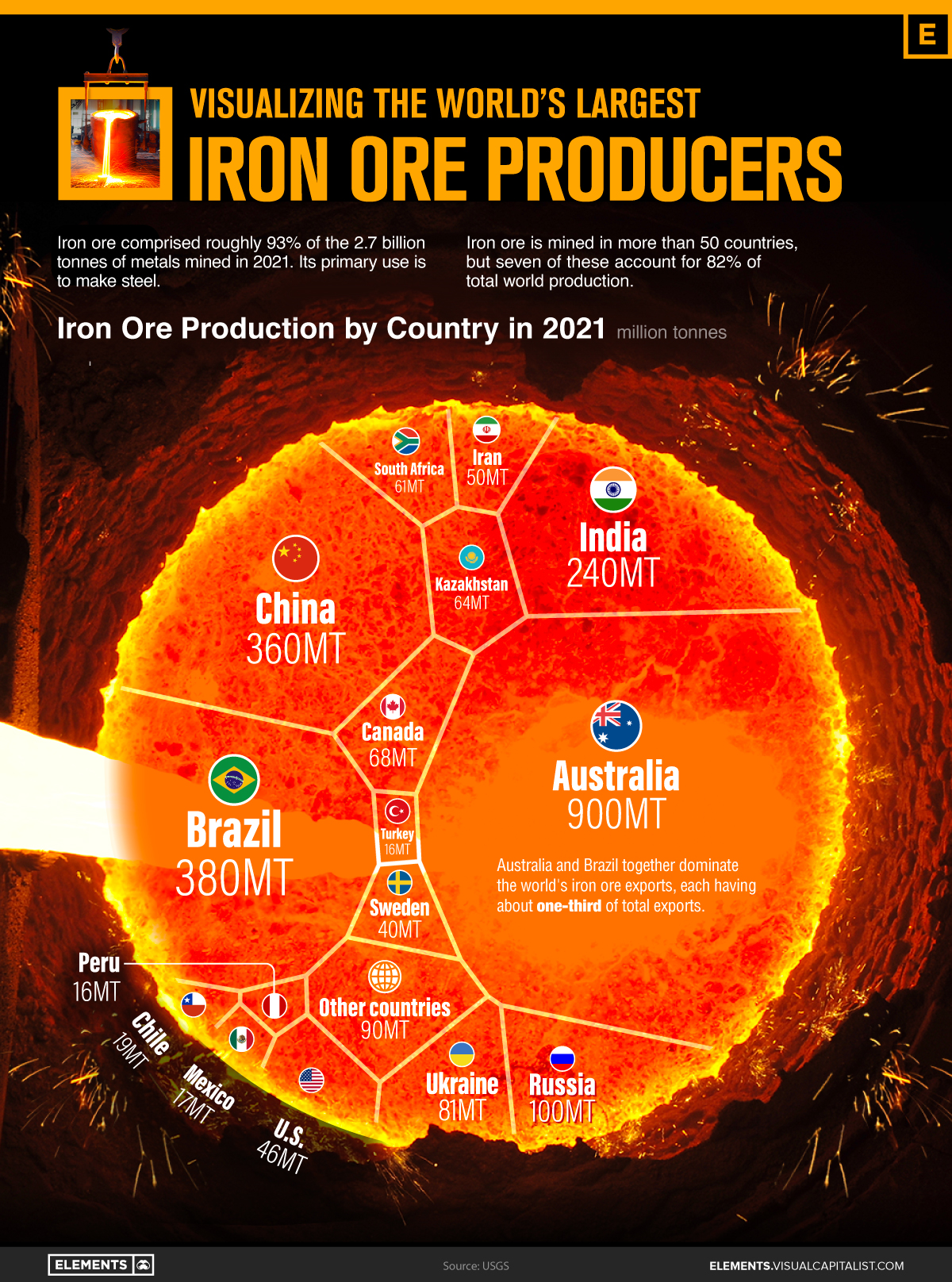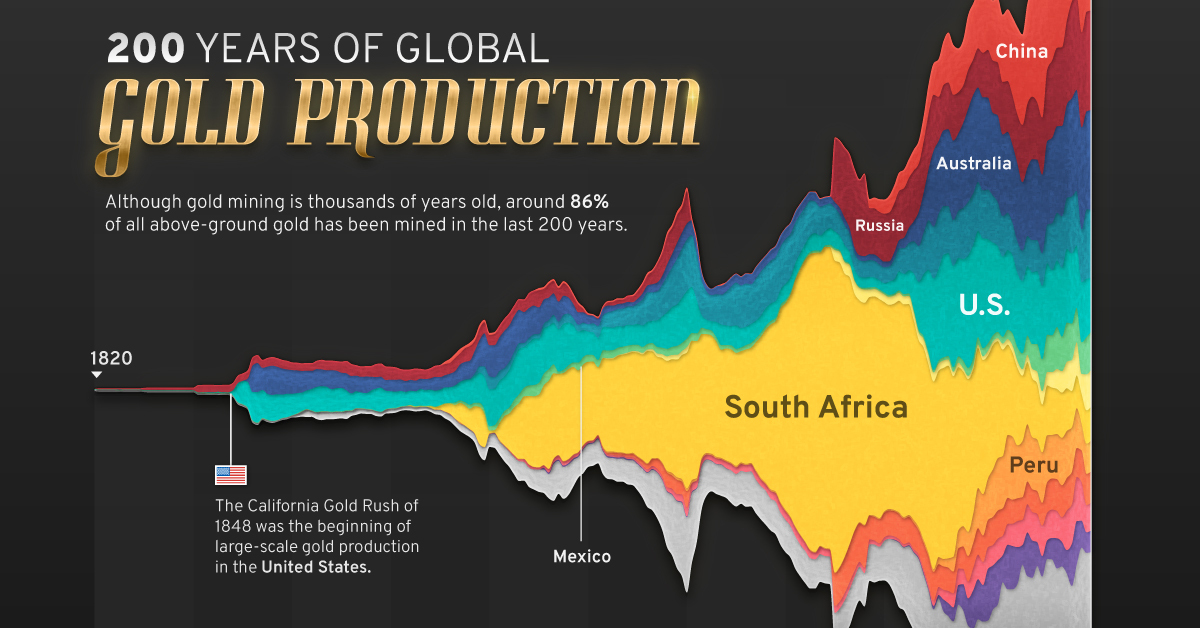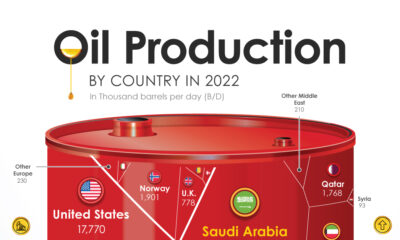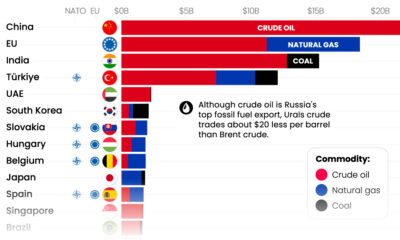Real Assets
Visualizing the World’s Largest Iron Ore Producers

Visualizing the World’s Largest Iron Ore Producers
Iron ore comprised roughly 93% of the 2.7 billion tonnes of metals mined in 2021.
It is used primarily (98%) to make steel, with the remaining 2% becoming magnets, auto parts, and catalysts.
Using data from the U.S. Geological Survey, the above infographic lists the world’s largest iron ore producers in 2021.
Pilbara and Carajás Iron Ore
Iron is the fourth most abundant element on the planet after oxygen, silicon, and aluminum, constituting about 5% of the Earth’s crust.
Australia produced 35% of the iron ore mined last year. Almost 90% of identified iron ore resources in the country occur in Western Australia, especially in the Pilbara region.
The large and dry region is known for its Aboriginal peoples and also for its red earth as a result of a chemical reaction of iron exposed to air and water. The three major Pilbara iron ore producers are also among the top mining companies in the world: BHP Group, Rio Tinto Ltd, and Fortescue Metals.
| Country | 2021 Production (Tonnes) |
|---|---|
| 🇦🇺 Australia | 900,000,000 |
| 🇧🇷 Brazil | 380,000,000 |
| 🇨🇳 China | 360,000,000 |
| 🇮🇳 India | 240,000,000 |
| 🇷🇺 Russia | 100,000,000 |
| 🇺🇦 Ukraine | 81,000,000 |
| 🇨🇦 Canada | 68,000,000 |
| 🇿🇦 South Africa | 61,000,000 |
| 🇰🇿 Kazakhstan | 64,000,000 |
| 🇮🇷 Iran | 50,000,000 |
| 🇺🇸 United States | 46,000,000 |
| 🇸🇪 Sweden | 40,000,000 |
| 🇨🇱 Chile | 19,000,000 |
| 🇲🇽 Mexico | 17,000,000 |
| 🇵🇪 Peru | 16,000,000 |
| 🇹🇷 Turkey | 16,000,000 |
| 🌐 Other countries | 90,000,000 |
After Australia, Brazil is the second biggest producer, with iron ore accounting for 80% of the country’s mining exports.
Brazil’s biggest public company, Vale, is the world’s largest producer of iron ore and nickel. The company runs the Carajás mine, the largest iron ore mine in the world. Located in the state of Pará, in the north of the country, the mine is operated as an open-pit mine and is estimated to contain roughly 7.2 billion metric tons of iron ore.
Together, Australia and Brazil dominate the world’s iron ore exports, each having about one-third of total exports.
China is the largest consumer of iron ore, used to feed its steel industry.
Despite being the third largest producer, China still imports around 80% of the iron ore it uses each year. The country brought in 1.12 billion tonnes of the commodity last year.
Iron Ore’s Role in the Green Economy
Iron ore demand is expected to rise in the coming years as steel plays a crucial role in producing and distributing energy.
Steel is used extensively in agriculture, solar and wind power, and also in infrastructure for hydroelectric.
Furthermore, steel is used for the production of transformers, generators, and electric motors, along with ships, trucks, and trains.
Real Assets
Charted: The Value Gap Between the Gold Price and Gold Miners
While gold prices hit all-time highs, gold mining stocks have lagged far behind.

Gold Price vs. Gold Mining Stocks
This was originally posted on our Voronoi app. Download the app for free on Apple or Android and discover incredible data-driven charts from a variety of trusted sources.
Although the price of gold has reached new record highs in 2024, gold miners are still far from their 2011 peaks.
In this graphic, we illustrate the evolution of gold prices since 2000 compared to the NYSE Arca Gold BUGS Index (HUI), which consists of the largest and most widely held public gold production companies. The data was compiled by Incrementum AG.
Mining Stocks Lag Far Behind
In April 2024, gold reached a new record high as Federal Reserve Chair Jerome Powell signaled policymakers may delay interest rate cuts until clearer signs of declining inflation materialize.
Additionally, with elections occurring in more than 60 countries in 2024 and ongoing conflicts in Ukraine and Gaza, central banks are continuing to buy gold to strengthen their reserves, creating momentum for the metal.
Traditionally known as a hedge against inflation and a safe haven during times of political and economic uncertainty, gold has climbed over 11% so far this year.
According to Business Insider, gold miners experienced their best performance in a year in March 2024. During that month, the gold mining sector outperformed all other U.S. industries, surpassing even the performance of semiconductor stocks.
Still, physical gold has outperformed shares of gold-mining companies over the past three years by one of the largest margins in decades.
| Year | Gold Price | NYSE Arca Gold BUGS Index (HUI) |
|---|---|---|
| 2023 | $2,062.92 | $243.31 |
| 2022 | $1,824.32 | $229.75 |
| 2021 | $1,828.60 | $258.87 |
| 2020 | $1,895.10 | $299.64 |
| 2019 | $1,523.00 | $241.94 |
| 2018 | $1,281.65 | $160.58 |
| 2017 | $1,296.50 | $192.31 |
| 2016 | $1,151.70 | $182.31 |
| 2015 | $1,060.20 | $111.18 |
| 2014 | $1,199.25 | $164.03 |
| 2013 | $1,201.50 | $197.70 |
| 2012 | $1,664.00 | $444.22 |
| 2011 | $1,574.50 | $498.73 |
| 2010 | $1,410.25 | $573.32 |
| 2009 | $1,104.00 | $429.91 |
| 2008 | $865.00 | $302.41 |
| 2007 | $836.50 | $409.37 |
| 2006 | $635.70 | $338.24 |
| 2005 | $513.00 | $276.90 |
| 2004 | $438.00 | $215.33 |
| 2003 | $417.25 | $242.93 |
| 2002 | $342.75 | $145.12 |
| 2001 | $276.50 | $65.20 |
| 2000 | $272.65 | $40.97 |
Among the largest companies on the NYSE Arca Gold BUGS Index, Colorado-based Newmont has experienced a 24% drop in its share price over the past year. Similarly, Canadian Barrick Gold also saw a decline of 6.5% over the past 12 months.
Real Assets
200 Years of Global Gold Production, by Country
Global gold production has grown exponentially since the 1800s, with 86% of all above-ground gold mined in the last 200 years.

Visualizing Global Gold Production Over 200 Years
Although the practice of gold mining has been around for thousands of years, it’s estimated that roughly 86% of all above-ground gold was extracted in the last 200 years.
With modern mining techniques making large-scale production possible, global gold production has grown exponentially since the 1800s.
The above infographic uses data from Our World in Data to visualize global gold production by country from 1820 to 2022, showing how gold mining has evolved to become increasingly global over time.
A Brief History of Gold Mining
The best-known gold rush in modern history occurred in California in 1848, when James Marshall discovered gold in Sacramento Valley. As word spread, thousands of migrants flocked to California in search of gold, and by 1855, miners had extracted around $2 billion worth of gold.
The United States, Australia, and Russia were (interchangeably) the three largest gold producers until the 1890s. Then, South Africa took the helm thanks to the massive discovery in the Witwatersrand Basin, now regarded today as one of the world’s greatest ever goldfields.
South Africa’s annual gold production peaked in 1970 at 1,002 tonnes—by far the largest amount of gold produced by any country in a year.
With the price of gold rising since the 1980s, global gold production has become increasingly widespread. By 2007, China was the world’s largest gold-producing nation, and today a significant quantity of gold is being mined in over 40 countries.
The Top Gold-Producing Countries in 2022
Around 31% of the world’s gold production in 2022 came from three countries—China, Russia, and Australia, with each producing over 300 tonnes of the precious metal.
| Rank | Country | 2022E Gold Production, tonnes | % of Total |
|---|---|---|---|
| #1 | 🇨🇳 China | 330 | 11% |
| #2 | 🇷🇺 Russia | 320 | 10% |
| #3 | 🇦🇺 Australia | 320 | 10% |
| #4 | 🇨🇦 Canada | 220 | 7% |
| #5 | 🇺🇸 United States | 170 | 5% |
| #6 | 🇲🇽 Mexico | 120 | 4% |
| #7 | 🇰🇿 Kazakhstan | 120 | 4% |
| #8 | 🇿🇦 South Africa | 110 | 4% |
| #9 | 🇵🇪 Peru | 100 | 3% |
| #10 | 🇺🇿 Uzbekistan | 100 | 3% |
| #11 | 🇬🇭 Ghana | 90 | 3% |
| #12 | 🇮🇩 Indonesia | 70 | 2% |
| - | 🌍 Rest of the World | 1,030 | 33% |
| - | World Total | 3,100 | 100% |
North American countries Canada, the U.S., and Mexico round out the top six gold producers, collectively making up 16% of the global total. The state of Nevada alone accounted for 72% of U.S. production, hosting the world’s largest gold mining complex (including six mines) owned by Nevada Gold Mines.
Meanwhile, South Africa produced 110 tonnes of gold in 2022, down by 74% relative to its output of 430 tonnes in 2000. This long-term decline is the result of mine closures, maturing assets, and industrial conflict, according to the World Gold Council.
Interestingly, two smaller gold producers on the list, Uzbekistan and Indonesia, host the second and third-largest gold mining operations in the world, respectively.
The Outlook for Global Gold Production
As of April 25, gold prices were hovering around the $2,000 per ounce mark and nearing all-time highs. For mining companies, higher gold prices can mean more profits per ounce if costs remain unaffected.
According to the World Gold Council, mined gold production is expected to increase in 2023 and could surpass the record set in 2018 (3,300 tonnes), led by the expansion of existing projects in North America. The chances of record mine output could be higher if gold prices continue to increase.
-

 Electrification3 years ago
Electrification3 years agoRanked: The Top 10 EV Battery Manufacturers
-

 Electrification2 years ago
Electrification2 years agoThe Key Minerals in an EV Battery
-

 Real Assets3 years ago
Real Assets3 years agoThe World’s Top 10 Gold Mining Companies
-

 Misc3 years ago
Misc3 years agoAll the Metals We Mined in One Visualization
-

 Electrification3 years ago
Electrification3 years agoThe Biggest Mining Companies in the World in 2021
-

 Energy Shift2 years ago
Energy Shift2 years agoWhat Are the Five Major Types of Renewable Energy?
-

 Electrification2 years ago
Electrification2 years agoThe World’s Largest Nickel Mining Companies
-

 Electrification2 years ago
Electrification2 years agoMapped: Solar Power by Country in 2021






















